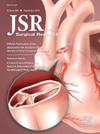肠扭转和地理海拔:秘鲁全国住院分析
IF 1.8
3区 医学
Q2 SURGERY
引用次数: 0
摘要
本研究旨在评估2023年秘鲁因肠扭转住院的地理分布,并分析地理海拔与住院率的关系。方法利用国家医疗卫生监督管理局的2023年住院数据库进行二次分析。肠扭转病例采用《国际疾病分类》第十次修订代码K56.2进行鉴定。海拔高度数据,使用标准换算系数(1米= 3.281英尺)以海平面以上米和英尺(英尺)为单位测量。住院率按年龄标准化,采用世界卫生组织每10万人的人口标准。使用Pearson相关性来评估海拔与住院率之间的关系。结果2023年共有614例肠扭转住院,其中男性发生率较高(72.1%),65岁及以上人群发生率较高。库斯科的年龄标准化住院率最高(每10万人8.32人;95%置信区间[CI]: 6.88-9.98)和Ayacucho (5.42;95% ci: 3.91-7.41)。高海拔地区(海拔3000米或9843英尺)的住院率最高,海拔与年龄标准化住院率之间存在中度正相关(r = 0.65;95% ci: 0.34-0.83;P & lt;0.001)。库斯科的安东尼奥·洛雷纳医院报告的病例最多(46例)。结论秘鲁高海拔地区肠扭转住院发生率较高,海拔与住院率呈显著正相关。这些结果提示,与高海拔生活有关的环境因素可能与肠扭转的发生有关。本文章由计算机程序翻译,如有差异,请以英文原文为准。
Intestinal Volvulus and Geographic Altitude: Nationwide Analysis of Hospitalizations in Peru
Introduction
This study aimed to evaluate the geographic distribution of hospitalizations due to intestinal volvulus in Peru during 2023 and to analyze the relationship between geographic altitude and hospitalization rates.
Methods
A secondary analysis was conducted using the 2023 hospitalizations database from the Superintendencia Nacional de Salud. Cases of intestinal volvulus were identified using the International Classification of Diseases, tenth revision code K56.2. Altitude data, measured in both meters above sea level and feet (ft) using the standard conversion factor (1 m = 3.281 ft). Hospitalization rates were standardized by age using World Health Organization population standards per 100,000 people. Pearson's correlation was used to assess the relationship between altitude and hospitalization rates.
Results
A total of 614 hospitalizations due to intestinal volvulus were recorded in 2023, with higher rates observed in men (72.1%) and individuals aged 65 y or older. The highest age-standardized hospitalization rates were reported in Cusco (8.32 per 100,000 people; 95% confidence interval [CI]: 6.88-9.98) and Ayacucho (5.42; 95% CI: 3.91-7.41). Departments located at high altitudes (>3000 meters above sea level or ∼9843 ft) showed the highest rates, with a moderate positive correlation between altitude and age-standardized hospitalization rates (r = 0.65; 95% CI: 0.34-0.83; P < 0.001). The Hospital Antonio Lorena in Cusco reported the highest number of cases (46).
Conclusions
Hospitalizations due to intestinal volvulus in Peru are more frequent in high-altitude regions, with a significant positive correlation between altitude and hospitalization rates. These findings suggest that environmental factors associated with high-altitude living may contribute to the occurrence of intestinal volvulus.
求助全文
通过发布文献求助,成功后即可免费获取论文全文。
去求助
来源期刊
CiteScore
3.90
自引率
4.50%
发文量
627
审稿时长
138 days
期刊介绍:
The Journal of Surgical Research: Clinical and Laboratory Investigation publishes original articles concerned with clinical and laboratory investigations relevant to surgical practice and teaching. The journal emphasizes reports of clinical investigations or fundamental research bearing directly on surgical management that will be of general interest to a broad range of surgeons and surgical researchers. The articles presented need not have been the products of surgeons or of surgical laboratories.
The Journal of Surgical Research also features review articles and special articles relating to educational, research, or social issues of interest to the academic surgical community.

 求助内容:
求助内容: 应助结果提醒方式:
应助结果提醒方式:


